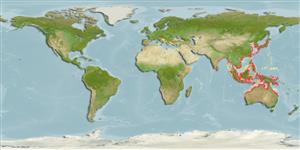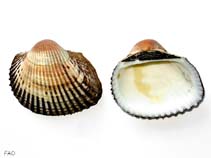Anadara inaequivalvis (Bruguière, 1789)
Inequivalve ark| Native range | All suitable habitat | Point map | Year 2050 |

|
| This map was computer-generated and has not yet been reviewed. |
| Anadara inaequivalvis AquaMaps Data sources: GBIF OBIS |
Classification / Names Common names | Synonyms | CoL | ITIS | WoRMS
Bivalvia | Arcida | Arcidae
Environment: milieu / climate zone / depth range / distribution range Ecology
Benthic; brackish; depth range 0 - 30 m (Ref. 108826), usually 15 - 25 m (Ref. 108821). Tropical; 47°N - 26°S, 32°E - 154°E
Distribution Countries | FAO areas | Ecosystems | Occurrences | Introductions
Indo-West Pacific. Introduced in the Mediterranean and Black Sea. Tropical to subtropical.
Length at first maturity / Size / Weight / Age
Maturity: Lm ? range ? - ? cm Max length : 9.5 cm TL male/unsexed; (Ref. 348); common length : 8.0 cm TL male/unsexed; (Ref. 348)
Short description Morphology
Shell thick and solid, inflated, inequilateral, roughly quadrate in shape with arcuate ventral margin and obliquely truncate posterior margin; slightly inequivalve, left valve distinctly overlapping the right valve ventrally and posteriorly. Cardinal area rather long and narrow. About 33 radial ribs (30 to 36) at each valve; ribs as wide as the interstices, granulated on left valve. Periostracum well developed. Internal margins with strong crenulations corresponding with the external radial ribs. No byssal gape. Colour: outside of shell white under the blackish brown periostracum. Inner side whitish.
Common depth values based on occurrence.
Life cycle and mating behavior Maturity | Reproduction | Spawning | Eggs | Fecundity | Larvae
Members of the class Bivalvia are mostly gonochoric, some are protandric hermaphrodites. Life cycle: Embryos develop into free-swimming trocophore larvae, succeeded by the bivalve veliger, resembling a miniature clam.
Main reference
References | Coordinator | Collaborators
Poutiers, J.M. 1998. (Ref. 348)
IUCN Red List Status (Ref. 130435: Version 2024-1)
CITES status (Ref. 108899)
Not Evaluated
CMS (Ref. 116361)
Not Evaluated
Threat to humans
Human uses
Fisheries: commercial
| FishSource | Sea Around Us
Tools
More information
Trophic Ecology
Food items
Diet
Food consumption
Ration
Predators
Diet
Food consumption
Ration
Predators
Ecology
Population dynamics
Life cycle
Distribution
Human Related
Aquaculture profile
Stamps, Coins Misc.
Stamps, Coins Misc.
Outreach
References
Internet sources
BHL | BOLD Systems | CISTI | DiscoverLife | FAO(Publication : search) | Fishipedia | GenBank (genome, nucleotide) | GloBI | Gomexsi | Google Books | Google Scholar | Google | PubMed | Tree of Life | Wikipedia (Go, Search) | Zoological Record
Estimates based on models
Preferred temperature
(Ref. 115969): 18.3 - 29.1, mean 28.2 (based on 598 cells).
Resilience
(Ref. 69278):
Medium, minimum population doubling time 1.4 - 4.4 years (K=0.2).
Price category
(Ref. 80766):
Unknown.



